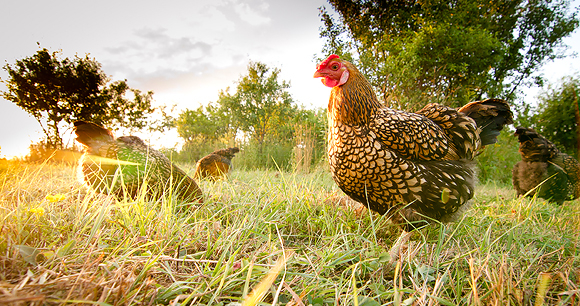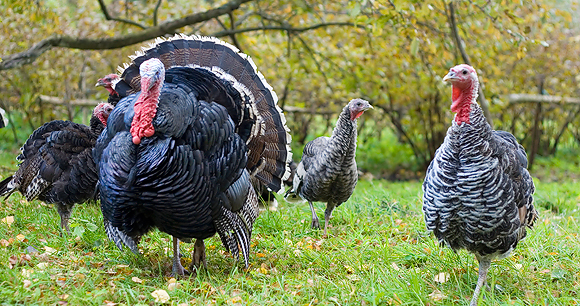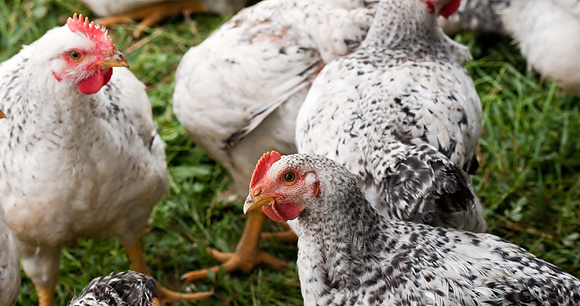
Poultry are reared for their meat and eggs. Learn more about egg-laying hens, turkeys, and chickens raised for meat.
Egg-laying Hens
At the start of 2023, about 64 percent of the over 309 million egg-laying hens in the United States were confined to barren battery cages where they are crowded and deprived of the ability to perform natural behaviors such as exploring, nesting, perching, dust bathing, or simply stretching their wings. Birds endure painful beak trimming, stand on wire floors that cripple their legs, breathe toxic air, and live their entire lives under unnatural, dim lighting.
In spite of the appalling conditions, profit and productivity for the industry remains high because the hens have been genetically selected to produce an excess of eggs—at the expense of their own health and welfare.
High-welfare, pasture-based farms represent a dramatic welfare improvement for egg-laying chickens. They raise modest-sized flocks of chickens who produce eggs at a normal rate. Birds on pasture can run, fly, stretch, and flap their wings, and have access to forage, dust baths, fresh air and sunlight. These egg-laying hens have space to themselves and access to protected nest boxes for laying. Beak (or other) mutilations are prohibited.
Turkeys
Approximately 208 million turkeys were raised for meat in 2022 in the United States, according to the US Department of Agriculture.
Turkeys suffer similar welfare problems as do chickens raised for meat. Industrial turkey farms confine birds inside huge sheds that are often windowless and artificially ventilated. Large industrial operations can house 10,000 birds in one building. The birds are packed tightly together with only about 2.5 square feet for females and 4 square feet for males. It is standard practice to perform painful mutilations such as beak, toe, and snood (part of the waddle) removal to prevent turkeys from injuring or cannibalizing each other in the intensely crowded quarters. High mortality rates are common; millions of turkeys die on the farm before they can be sent to slaughter.

High levels of ammonia contribute to very poor air quality and painful irritations to the turkeys’ feet. Lighting is intentionally kept low to minimize aggression and activity so birds gain weight more rapidly. An especially serious welfare problem is that the turkeys are genetically selected to grow at such an abnormally fast rate that their bodies cannot keep up. Turkeys grow so big they are unable to mate naturally; the industry must use artificial insemination to breed them. Breeding turkeys have their feed rationed, leaving them hungry, just to keep down the rapid weight gain programmed into their genes so as to keep them alive longer.
High-welfare, pasture-based farms represent a dramatic welfare improvement for turkeys. They raise turkeys who mature at a normal rate in modest-sized flocks. Artificial insemination is typically prohibited. Birds on pasture can run, fly, stretch, and flap their wings, and have access to forage, dust baths, fresh air, and sunlight. Beak, toe, snood, or other mutilations are usually prohibited.
Meat Chickens
According to statistics from the USDA, over 9.5 billion chickens were slaughtered for meat in the United States in 2022.
Industrial meat chicken farms confine birds inside massive, windowless sheds. They are packed tightly together with as little as 100 square inches of space, in accordance with National Chicken Council guidelines. (The birds would need 138 square inches to spread just one wing.) Industrial farms may house up to 50,000 birds in one building. This extreme overcrowding prevents chickens from performing natural behaviors such as pecking, preening, or even walking around without stepping on other birds.

High levels of ammonia in the litter contribute to extremely poor air quality and painful irritations to the chickens’ feet. Lighting is intentionally kept low to minimize aggression and activity, so birds gain weight more rapidly. An especially serious welfare problem is that the birds are genetically selected to grow at such an abnormally fast rate that their bodies cannot keep up. Their bones break and organs rupture as chickens reach market weight in just six or seven weeks. Some die of heart failure before that.
High-welfare, pasture-based farms represent a dramatic improvement in the welfare of chickens raised for meat. They raise chickens who mature at a normal rate, in modest-sized flocks. Birds on pasture can run, fly, stretch, and flap their wings, and have access to forage, dust baths, fresh air, and sunlight.